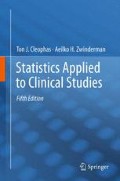Abstract
Polynomial analysis is an extension of simple linear regression, where a model is used to allow for the existence of a systematic dependence of the dependent y variable (blood pressure) on the independent x variable (time) different from a linear dependence.
Access this chapter
Tax calculation will be finalised at checkout
Purchases are for personal use only
References
Bleniaszewski L, Staessen JA, Byttebier G, De Leeuw PW, Van Hedent T, Fagard R (1997) Trough-to-peak versus surface ration in the assessment of antihypertensive agents. Blood Press 4:350–357
Harvard Graphics-3 (2001) Statistical software. Harvard, Inc, Boston
Hays WL (1988) Curvilinear regression. In: Hays WL (ed) Statistics, 4th edn. Holt, Rinehart and Winston, Inc, Chicago, pp 698–716
Lemmer B, Scheidel B, Behne S (1991) Chronopharmacokinetics and chronopharmacodynamics of cardiovascular active drugs: propranolol, organic nitrates, nifedipine. Ann N Y Acad Sci 618:166–171
O’Brien E, Atkins N, Staessen J (1995) State of the market, a review of ambulatory blood pressure-monitoring devices. Hypertension 26:835–842
Omboni S, Parati G, Palatini P, Vanasia A, Muiesan ML, Cuspidi C, Mancia G (1998) Reproducibility and clinical value of nocturnal hypotension: prospective evidence from the SAMPLE study. J Hypertens 16:733–738
Owens P, Lyons S, O’Brien E (1998) Ambulatory blood pressure in hypertensive population: patterns and prevalence of hypertensive subforms. J Hypertens 16:1735–1745
Scheidel B, Lemmer B, Blume H (1990) Influence of time of day on pharmacokinetics and hemodynamic effects of beta-blockers. In: Clinical chronopharmacology, vol 6. Zuckschwerdt Verlag, Munich, pp 75–79
SPSS (2002) Statistical software. Professional statistics. Chicago
Van de Luit L, Van der Meulen J, Cleophas TJ, Zwinderman AH (1998a) Amplified amplitudes of circadian rhythms and nighttime hypotension in patients with chronic fatigue syndrome; improvement by inopamil but not by melatonin. Eur J Intern Med 9:99–103
Van de Luit L, Cleophas TJ, Van der Meulen J, Zwinderman AH (1998b) Nighttime hypotension in mildly hypertensive patients prevented by beta-blockers but not by ACE-inhibitors or calcium channel blockers. Eur J Intern Med 9:251–256
Zanchetti A (1997) Twenty-four-hour ambulatory blood pressure evaluation of antihypertensive agents. J Hypertens 15:S21–S25
Author information
Authors and Affiliations
Rights and permissions
Copyright information
© 2012 Springer Science+Business Media B.V.
About this chapter
Cite this chapter
Cleophas, T.J., Zwinderman, A.H. (2012). Curvilinear Regression. In: Statistics Applied to Clinical Studies. Springer, Dordrecht. https://doi.org/10.1007/978-94-007-2863-9_16
Download citation
DOI: https://doi.org/10.1007/978-94-007-2863-9_16
Published:
Publisher Name: Springer, Dordrecht
Print ISBN: 978-94-007-2862-2
Online ISBN: 978-94-007-2863-9
eBook Packages: Biomedical and Life SciencesBiomedical and Life Sciences (R0)

